2012 Hyundai Sonata steering wheel
[x] Cancel search: steering wheelPage 288 of 411
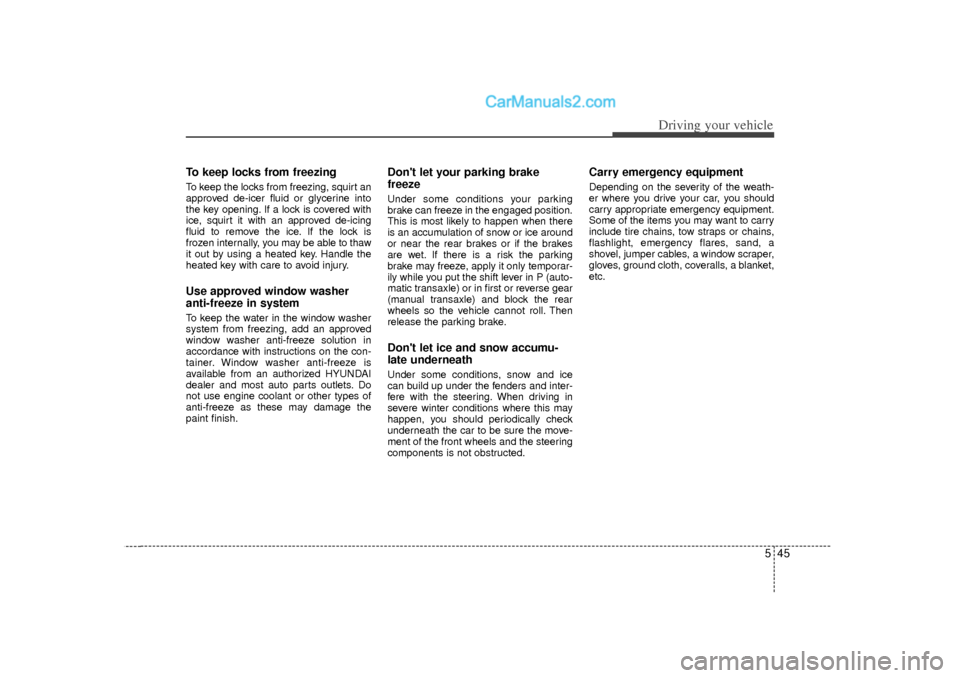
545
Driving your vehicle
To keep locks from freezingTo keep the locks from freezing, squirt an
approved de-icer fluid or glycerine into
the key opening. If a lock is covered with
ice, squirt it with an approved de-icing
fluid to remove the ice. If the lock is
frozen internally, you may be able to thaw
it out by using a heated key. Handle the
heated key with care to avoid injury.Use approved window washer
anti-freeze in systemTo keep the water in the window washer
system from freezing, add an approved
window washer anti-freeze solution in
accordance with instructions on the con-
tainer. Window washer anti-freeze is
available from an authorized HYUNDAI
dealer and most auto parts outlets. Do
not use engine coolant or other types of
anti-freeze as these may damage the
paint finish.
Don't let your parking brake
freezeUnder some conditions your parking
brake can freeze in the engaged position.
This is most likely to happen when there
is an accumulation of snow or ice around
or near the rear brakes or if the brakes
are wet. If there is a risk the parking
brake may freeze, apply it only temporar-
ily while you put the shift lever in P (auto-
matic transaxle) or in first or reverse gear
(manual transaxle) and block the rear
wheels so the vehicle cannot roll. Then
release the parking brake.Don't let ice and snow accumu-
late underneathUnder some conditions, snow and ice
can build up under the fenders and inter-
fere with the steering. When driving in
severe winter conditions where this may
happen, you should periodically check
underneath the car to be sure the move-
ment of the front wheels and the steering
components is not obstructed.
Carry emergency equipmentDepending on the severity of the weath-
er where you drive your car, you should
carry appropriate emergency equipment.
Some of the items you may want to carry
include tire chains, tow straps or chains,
flashlight, emergency flares, sand, a
shovel, jumper cables, a window scraper,
gloves, ground cloth, coveralls, a blanket,
etc.
Page 322 of 411
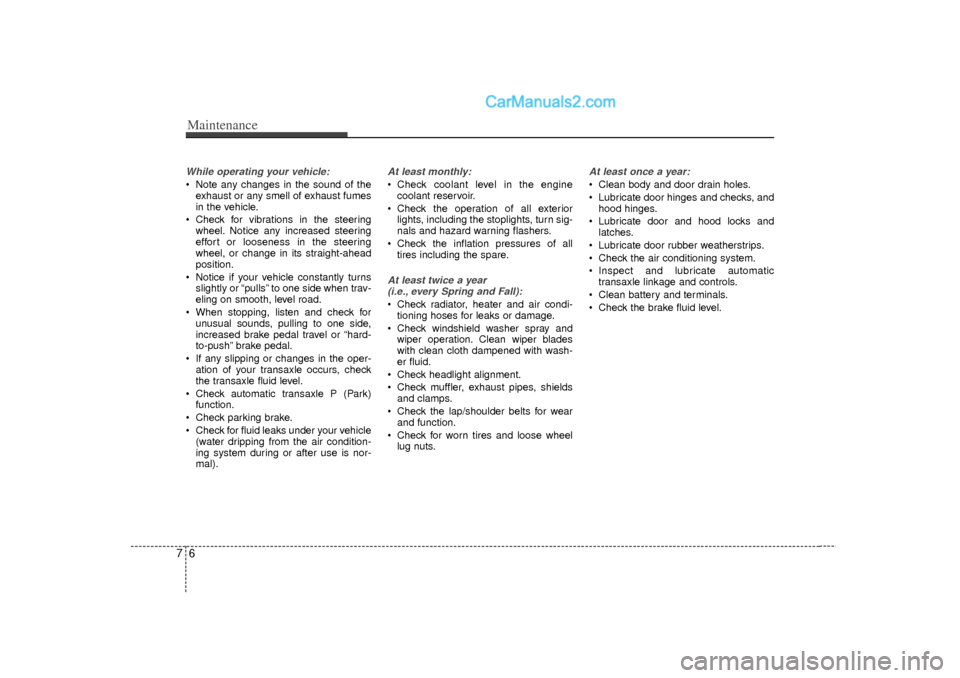
Maintenance67While operating your vehicle: Note any changes in the sound of theexhaust or any smell of exhaust fumes
in the vehicle.
Check for vibrations in the steering wheel. Notice any increased steering
effort or looseness in the steering
wheel, or change in its straight-ahead
position.
Notice if your vehicle constantly turns slightly or “pulls” to one side when trav-
eling on smooth, level road.
When stopping, listen and check for unusual sounds, pulling to one side,
increased brake pedal travel or “hard-
to-push” brake pedal.
If any slipping or changes in the oper- ation of your transaxle occurs, check
the transaxle fluid level.
Check automatic transaxle P (Park) function.
Check parking brake.
Check for fluid leaks under your vehicle (water dripping from the air condition-
ing system during or after use is nor-
mal).
At least monthly: Check coolant level in the enginecoolant reservoir.
Check the operation of all exterior lights, including the stoplights, turn sig-
nals and hazard warning flashers.
Check the inflation pressures of all tires including the spare.At least twice a year (i.e., every Spring and Fall): Check radiator, heater and air condi- tioning hoses for leaks or damage.
Check windshield washer spray and wiper operation. Clean wiper blades
with clean cloth dampened with wash-
er fluid.
Check headlight alignment.
Check muffler, exhaust pipes, shields and clamps.
Check the lap/shoulder belts for wear and function.
Check for worn tires and loose wheel lug nuts.
At least once a year: Clean body and door drain holes.
Lubricate door hinges and checks, andhood hinges.
Lubricate door and hood locks and latches.
Lubricate door rubber weatherstrips.
Check the air conditioning system.
Inspect and lubricate automatic transaxle linkage and controls.
Clean battery and terminals.
Check the brake fluid level.
Page 337 of 411
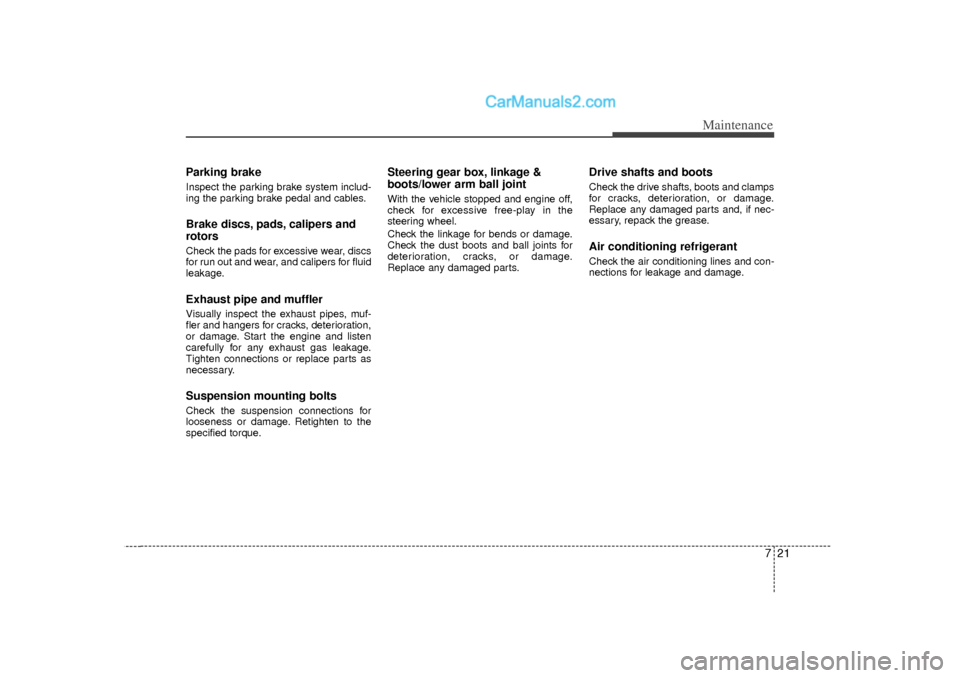
721
Maintenance
Parking brakeInspect the parking brake system includ-
ing the parking brake pedal and cables.Brake discs, pads, calipers and
rotorsCheck the pads for excessive wear, discs
for run out and wear, and calipers for fluid
leakage.Exhaust pipe and mufflerVisually inspect the exhaust pipes, muf-
fler and hangers for cracks, deterioration,
or damage. Start the engine and listen
carefully for any exhaust gas leakage.
Tighten connections or replace parts as
necessary.Suspension mounting boltsCheck the suspension connections for
looseness or damage. Retighten to the
specified torque.
Steering gear box, linkage &
boots/lower arm ball jointWith the vehicle stopped and engine off,
check for excessive free-play in the
steering wheel.
Check the linkage for bends or damage.
Check the dust boots and ball joints for
deterioration, cracks, or damage.
Replace any damaged parts.
Drive shafts and bootsCheck the drive shafts, boots and clamps
for cracks, deterioration, or damage.
Replace any damaged parts and, if nec-
essary, repack the grease.Air conditioning refrigerant Check the air conditioning lines and con-
nections for leakage and damage.
Page 357 of 411
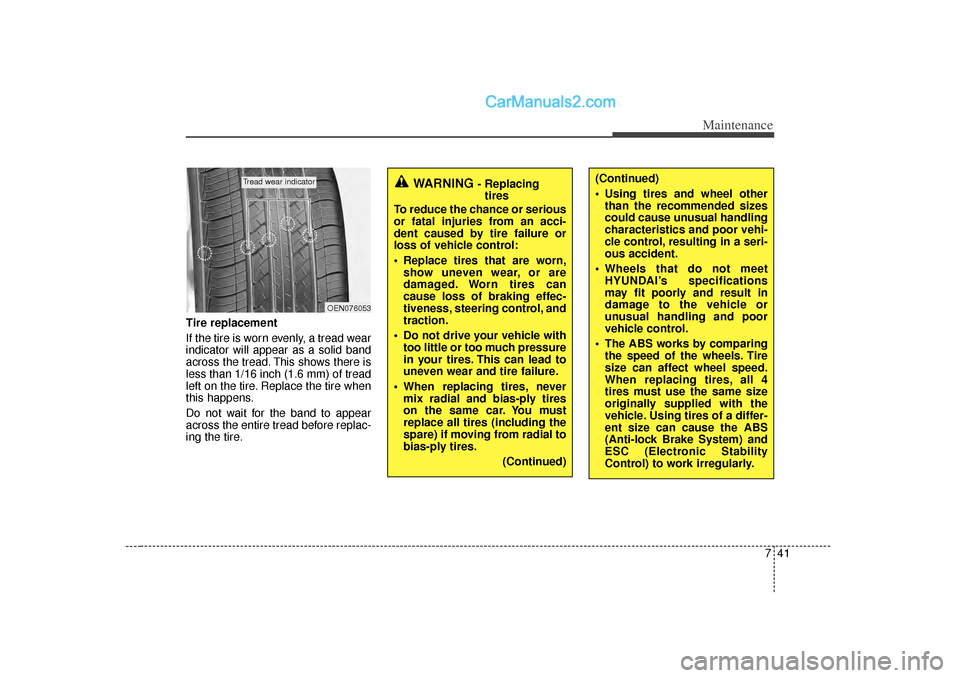
741
Maintenance
Tire replacement
If the tire is worn evenly, a tread wear
indicator will appear as a solid band
across the tread. This shows there is
less than 1/16 inch (1.6 mm) of tread
left on the tire. Replace the tire when
this happens.
Do not wait for the band to appear
across the entire tread before replac-
ing the tire.
OEN076053
Tread wear indicator
WARNING
- Replacingtires
To reduce the chance or serious
or fatal injuries from an acci-
dent caused by tire failure or
loss of vehicle control:
Replace tires that are worn, show uneven wear, or are
damaged. Worn tires can
cause loss of braking effec-
tiveness, steering control, and
traction.
Do not drive your vehicle with too little or too much pressure
in your tires. This can lead to
uneven wear and tire failure.
When replacing tires, never mix radial and bias-ply tires
on the same car. You must
replace all tires (including the
spare) if moving from radial to
bias-ply tires.
(Continued)
(Continued)
Using tires and wheel otherthan the recommended sizes
could cause unusual handling
characteristics and poor vehi-
cle control, resulting in a seri-
ous accident.
Wheels that do not meet HYUNDAI’s specifications
may fit poorly and result in
damage to the vehicle or
unusual handling and poor
vehicle control.
The ABS works by comparing the speed of the wheels. Tire
size can affect wheel speed.
When replacing tires, all 4
tires must use the same size
originally supplied with the
vehicle. Using tires of a differ-
ent size can cause the ABS
(Anti-lock Brake System) and
ESC (Electronic Stability
Control) to work irregularly.
Page 387 of 411
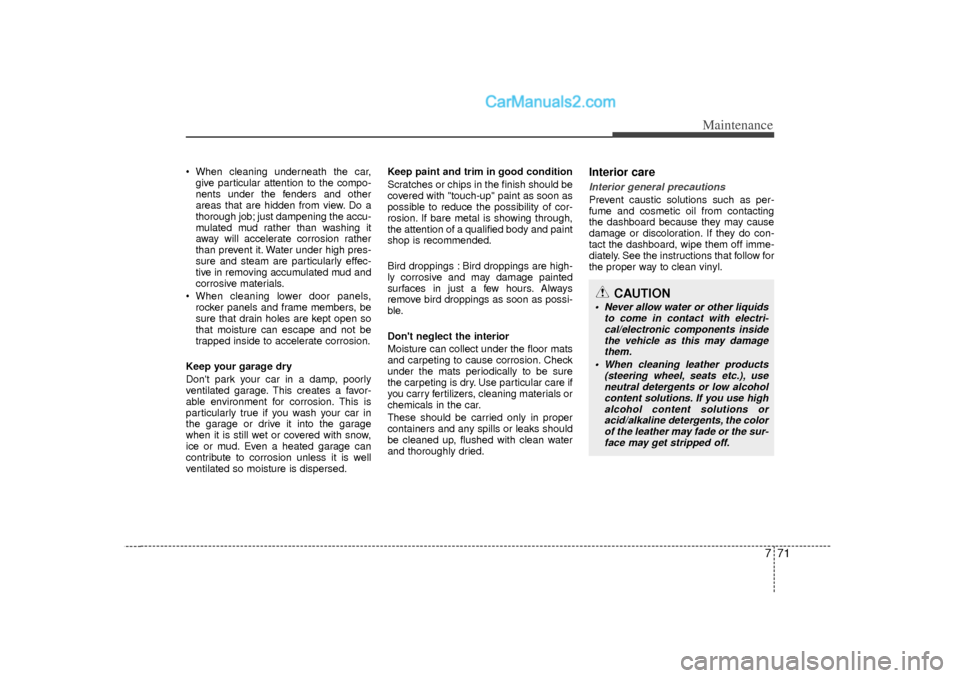
771
Maintenance
When cleaning underneath the car,give particular attention to the compo-
nents under the fenders and other
areas that are hidden from view. Do a
thorough job; just dampening the accu-
mulated mud rather than washing it
away will accelerate corrosion rather
than prevent it. Water under high pres-
sure and steam are particularly effec-
tive in removing accumulated mud and
corrosive materials.
When cleaning lower door panels, rocker panels and frame members, be
sure that drain holes are kept open so
that moisture can escape and not be
trapped inside to accelerate corrosion.
Keep your garage dry
Don't park your car in a damp, poorly
ventilated garage. This creates a favor-
able environment for corrosion. This is
particularly true if you wash your car in
the garage or drive it into the garage
when it is still wet or covered with snow,
ice or mud. Even a heated garage can
contribute to corrosion unless it is well
ventilated so moisture is dispersed. Keep paint and trim in good condition
Scratches or chips in the finish should be
covered with "touch-up" paint as soon as
possible to reduce the possibility of cor-
rosion. If bare metal is showing through,
the attention of a qualified body and paint
shop is recommended.
Bird droppings : Bird droppings are high-
ly corrosive and may damage painted
surfaces in just a few hours. Always
remove bird droppings as soon as possi-
ble.
Don't neglect the interior
Moisture can collect under the floor mats
and carpeting to cause corrosion. Check
under the mats periodically to be sure
the carpeting is dry. Use particular care if
you carry fertilizers, cleaning materials or
chemicals in the car.
These should be carried only in proper
containers and any spills or leaks should
be cleaned up, flushed with clean water
and thoroughly dried.
Interior careInterior general precautions Prevent caustic solutions such as per-
fume and cosmetic oil from contacting
the dashboard because they may cause
damage or discoloration. If they do con-
tact the dashboard, wipe them off imme-
diately. See the instructions that follow for
the proper way to clean vinyl.
CAUTION
Never allow water or other liquids
to come in contact with electri-cal/electronic components insidethe vehicle as this may damage them.
When cleaning leather products (steering wheel, seats etc.), useneutral detergents or low alcoholcontent solutions. If you use high alcohol content solutions oracid/alkaline detergents, the colorof the leather may fade or the sur- face may get stripped off.
Page 403 of 411
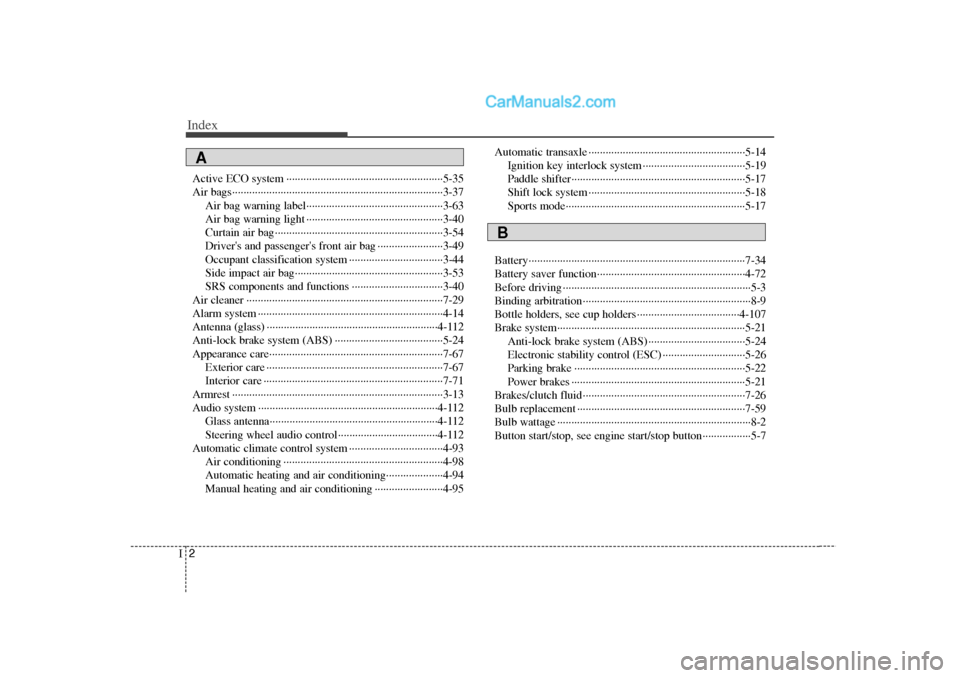
Index2I
Active ECO system ··················\
··················\
··················\
·5-35
Air bags··················\
··················\
··················\
··················\
··3-37Air bag warning label··················\
··················\
············3-63
Air bag warning light ··················\
··················\
············3-40
Curtain air bag··················\
··················\
··················\
·····3-54
Driver's and passenger's front air bag ··················\
·····3-49
Occupant classification system ··················\
···············3-44
Side impact air bag··················\
··················\
················3-53
SRS components and functions ··················\
··············3-40
Air cleaner ··················\
··················\
··················\
···············7-29
Alarm system ··················\
··················\
··················\
···········4-14
Antenna (glass) ··················\
··················\
··················\
······4-112
Anti-lock brake system (ABS) ··················\
··················\
··5-24
Appearance care··················\
··················\
··················\
·······7-67 Exterior care ··················\
··················\
··················\
········7-67
Interior care ··················\
··················\
··················\
·········7-71
Armrest ··················\
··················\
··················\
··················\
··3-13
Audio system ··················\
··················\
··················\
·········4-112 Glass antenna··················\
··················\
··················\
·····4-112
Steering wheel audio control··················\
·················4-112
Automatic climate control system ··················\
···············4-93 Air conditioning ··················\
··················\
··················\
··4-98
Automatic heating and air conditioning··················\
··4-94
Manual heating and air conditioning ··················\
······4-95 Automatic transaxle ··················\
··················\
··················\
·5-14
Ignition key interlock system ··················\
··················\
5-19
Paddle shifter··················\
··················\
··················\
·······5-17
Shift lock system ··················\
··················\
··················\
·5-18
Sports mode··················\
··················\
··················\
·········5-17
Battery··················\
··················\
··················\
··················\
····7-34
Battery saver function··················\
··················\
················4-72
Before driving ··················\
··················\
··················\
············5-3
Binding arbitration ··················\
··················\
··················\
·····8-9
Bottle holders, see cup holders ··················\
··················\
4-107
Brake system··················\
··················\
··················\
············5-21 Anti-lock brake system (ABS) ··················\
················5-24
Electronic stability control (ESC) ··················\
···········5-26
Parking brake ··················\
··················\
··················\
······5-22
Power brakes ··················\
··················\
··················\
·······5-21
Brakes/clutch fluid ··················\
··················\
··················\
···7-26
Bulb replacement ··················\
··················\
··················\
·····7-59
Bulb wattage ··················\
··················\
··················\
··············8-2
Button start/stop, see engine start/stop button·················5-7A
B
Page 410 of 411
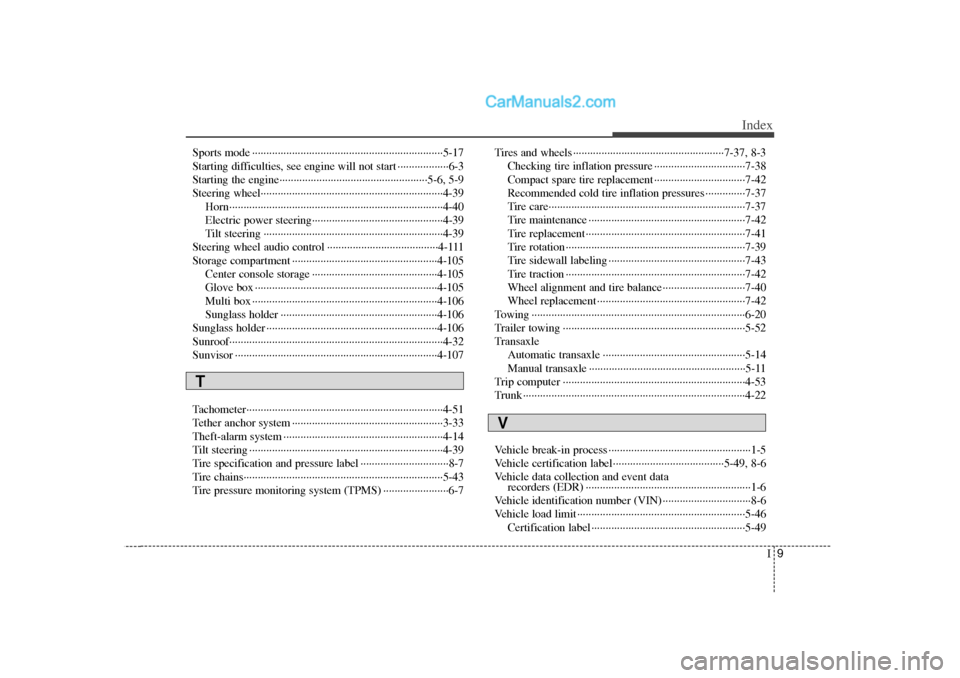
I9
Index
Sports mode ··················\
··················\
··················\
·············5-17
Starting difficulties, see engine will not start ··················\
6-3
Starting the engine··················\
··················\
················5-6, 5-9\
Steering wheel···············\
··················\
··················\
·············4-39Horn··················\
··················\
··················\
··················\
···4-40
Electric power steering··················\
··················\
··········4-39
Tilt steering ··················\
··················\
··················\
·········4-39
Steering wheel audio control ··················\
··················\
···4-111
Storage compartment ··················\
··················\
···············4-105 Center console storage ··················\
··················\
········4-105
Glove box ··················\
··················\
··················\
··········4-105
Multi box ··················\
··················\
··················\
···········4-106
Sunglass holder ··················\
··················\
··················\
·4-106
Sunglass holder ··················\
··················\
··················\
······4-106
Sunroof··················\
··················\
··················\
··················\
···4-32
Sunvisor ··················\
··················\
··················\
·················4-10\
7
Tachometer··················\
··················\
··················\
···············4-51
Tether anchor system ··················\
··················\
·················3-33\
Theft-alarm system ··················\
··················\
··················\
··4-14
Tilt steering ··················\
··················\
··················\
··············4-39
Tire specification and pressure label ··················\
·············8-7
Tire chains··················\
··················\
··················\
················5-43
Tire pressure monitoring system (TPMS) ··················\
·····6-7 Tires and wheels ··················\
··················\
·················7-37\
, 8-3
Checking tire inflation pressure ··················\
··············7-38
Compact spare tire replacement ··················\
··············7-42
Recommended cold tire inflation pressures ··············7-37
Tire care··················\
··················\
··················\
···············7-37
Tire maintenance ··················\
··················\
··················\
·7-42
Tire replacement ··················\
··················\
··················\
··7-41
Tire rotation ··················\
··················\
··················\
·········7-39
Tire sidewall labeling ··················\
··················\
············7-43
Tire traction ··················\
··················\
··················\
·········7-42
Wheel alignment and tire balance ··················\
···········7-40
Wheel replacement ··················\
··················\
················7-42
Towing ··················\
··················\
··················\
··················\
···6-20
Trailer towing ··················\
··················\
··················\
··········5-52
Transaxle Automatic transaxle ··················\
··················\
··············5-14
Manual transaxle ··················\
··················\
··················\
·5-11
Trip computer ··················\
··················\
··················\
··········4-53
Trunk ··················\
··················\
··················\
··················\
······4-22
Vehicle break-in process ··················\
··················\
··············1-5
Vehicle certification label··················\
··················\
···5-49, 8-6
Vehicle data collection and event data recorders (EDR) ··················\
··················\
··················\
····1-6
Vehicle identification number (VIN) ··················\
·············8-6
Vehicle load limit ··················\
··················\
··················\
·····5-46 Certification label ··················\
··················\
··················\
5-49T
V